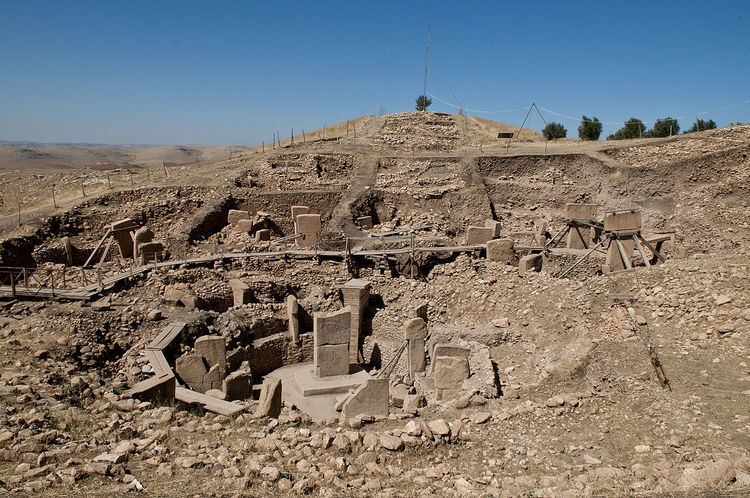The 10th millennium BC marks the beginning of the Mesolithic and Epipaleolithic periods, which is the first part of the Holocene epoch. Agriculture, based on the cultivation of primitive forms of millet and rice, occurred in Southwest Asia. Although agriculture was being developed in the Fertile Crescent, it would not be widely practiced for another 2,000 years.
The world population was between one and ten million people, most of whom were hunter-gatherer communities scattered over all continents except Antarctica and Zealandia. The Würm glaciation ended, and the beginning interglacial, which endures to this day, allowed the re-settlement of northern regions.
c. 10,000 BC: First cave drawings of the Mesolithic period are made, with war scenes and religious scenes.
c. 10,000 BC: Bottle Gourd is domesticated and used as a carrying vessel.
c. 10,000 BC: The end of the most recent glaciation.
c. 9700 BC: Younger Dryas cold period and the Pleistocene epoch ends, start of the Holocene epoch.
c. 9500 BC: There is evidence of harvesting, though not necessarily cultivation, of wild grasses in Asia Minor about this time.
c. 9500 BC: First building phase of the temple complex at Göbekli Tepe.
c. 9300 BC: Figs were apparently cultivated in the Jordan River valley.
c. 9100 BC: Oldest known megaliths are created at the Göbekli Tepe temple complexes, some up to 20 tons
c. 9000 BC: Neolithic culture began in Ancient Near East.
c. 9000 BC: Near East: First stone structures at Jericho are built.
Asia: Cave sites near the Caspian Sea are inhabited by humans.
Africa: Wall paintings found in Ethiopia and Eritrea depict human activity; some of the older paintings are thought to date back to around 10,000 BC.
Europe: Azilian (Painted Pebble Culture) people occupy northern Spain and Southern France.
Europe: Magdalenian culture flourishes and creates cave paintings in France.
Europe: Solutrean culture begins horse hunting.
Egypt: Early sickle blades and grain grinding stones appear
Jordan: Wadi Faynan (WF16): large, oval-shaped building. Early farmers lived here between 9,600 and 8,200 BC, cultivating wild plants such as wild barley, pistachio, and fig trees, and hunting or herding wild goats, cattle, and gazelle.
Kurdistan: Zagros mountains near Kermanshah: very early agriculture (wheat, barley).
Syria: Jerf el-Ahmar, occupied between 9200 and 8700 BC.
Japan: The Jōmon people use pottery, fish, hunt and gather acorns, nuts and edible seeds. There are 10,000 known sites.
Mesopotamia: People begin to collect wild wheat and barley probably to make malt then beer.
The oldest prehistoric village in the Middle East dating back to 9800 BC, Sahneh, was located in west of Kermanshah, in Kermanshah province.
Norway: First traces of population in Randaberg.
Persia: The goat is domesticated.
Sahara: Bubalus Period.
Paleo-Indian hunter-gatherer societies live nomadically in the countryside
Blackwater Draw forms in eastern New Mexico, evincing human activity
Folsom people flourish throughout the Southwestern United States
Settlement at the Nanu site in the Queen Charlotte Islands of modern-day British Columbia begins, starting the longest continual occupation in territory now belonging to Canada
Petroglyphs at Winnemucca Lake in what is today northwest Nevada were carved by this time, possibly as early as 12.8 kya to as late as 8,500 BC
Indigenous Australian peoples hunter-gather societies live nomadically in the countryside
Arnhem land-bridge floods over and Northern Australia is separated from Papua New Guinea
Aboriginal diet and land shift after great flooding, many Aboriginal people shift from land hunting such as the staple kangaroo and begin to fish on the new accessible coasts. Fish and turtles enter into indigenous art
The use of the multi-purpose boomerang disappears from use in Arnhem Land and northern indigenous communities
c. 10,000 BC:
North America: Dire wolf, Smilodon, giant beaver, ground sloth, giant Columbian mammoth (Mammuthus columbi), woolly mammoth, mastodons, giant short-faced bear, American cheetah, scimitar cats (Homotherium), American camels, American horses, and American lions all become extinct
Long Island becomes an island when waters break through on the western end to the interior lake
Bering Sea: Bering land bridge from Siberia to North America covered in water
Europe: Permanent ecological change. The savannah-dwelling reindeer, bison, and Paleolithic hunters withdraw to the sub-Arctic, leaving the rest to forest animals like deer, aurochs, and Mesolithic foragers (1967 McEvedy)
World: Allerod oscillation brings transient improvement in climate; sea levels rise abruptly and massive inland flooding occurs due to glacier melt
c. 9700 BC: Lake Agassiz forms
c. 9700 BC: Younger Dryas cold period ends; Pleistocene ends and Holocene begins; Paleolithic ends and Mesolithic begins; Large amounts of previously glaciated land become habitable again
c. 10,000 BC: This is the time setting for the video game Far Cry Primal, the film 10,000 BC, and the Opar novels by Philip José Farmer: Hadon of Ancient Opar and Flight to Opar. It is supposedly the setting for Robert E. Howard's Conan the Barbarian tales, The Hyborian Age, a "Fantasy Version of Earth", although other dating schema exist and Howard himself never set an official date for the Hyborian Age.
9564 BC: Destruction of Atlantis, according to theosophic tradition.
c. 9500 BC – 9000 BC; In Bryan Sykes' The Seven Daughters of Eve, the 'clan mother' of Haplogroup J lives in Asia Minor or the Fertile Crescent.
The Holocene calendar, devised by Cesare Emiliani in 1993, places its epoch at 10,000 BC (with the year 2017 being rendered as 12017 HE).

